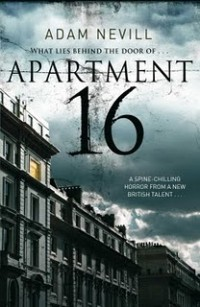
Book Review: ‘Apartment 16’ by Adam Nevill
Review by Ren Zelen
It’s been a very long time since a big UK publisher has shown much interest in a UK author of horror, not since the days of Clive Barker and James Herbert in fact. That’s why I was intrigued to find out what may have prompted their interest in Adam Nevill’s ‘Apartment 16’.
This is a novel about ‘the bad place’ to use one of Stephen King classifications, and is a story reminiscent of the haunted rooms of King’s Overlook Hotel and concerning another man’s descent into madness. But this ‘bad place’ is Barrington House, an upmarket block in London’s Mayfair district where there is an empty apartment, one that has been empty for fifty years. One night a young art-student, Seth, having taken the job of night watchman, hears a disturbance in the small hours of the morning and investigates, starting a chain of events which reveal Apartment 16 as a gateway to something vindictive and terrifying which begins to seep into the dark passages and dusty rooms inhabited by the mysterious, aged residents of Barrington house, and whose evil presence also begins to infiltrate Seth’s impressionable mind.
A young American woman, Apryl, arrives. She has inherited an apartment from her Great Aunt Lillian who died in strange circumstances. Rumours claim Lillian was mad, but her diary suggests she was implicated in some horrific event decades ago. Intrigued by the diaries, determined to fill in the gaps left by her eccentric relative, Apryl begins to unravel the hidden story of Barrington House and the truth about the presence that torments the inhabitants.
The book is successful in instilling a feeling of tension and disquiet in the reader. Nevill’s writing shows an intriguing marriage of old and the new styles. He employs the shadowy, barely-glimpsed horrors on the periphery of M.R. James’ and H.P. Lovecraft’s imaginations, the uneasy ambience of Blackwood and the raw, visceral descriptions of Clive Barker. Buildings and environments become characters in themselves and are infused with a brooding malevolence. London is shown at its most desolate, contrasting its squalor and faded grandeur – a permanently grey and drizzling backdrop to Seth’s growing existentialist nausea and descent into alienation and disgust at the degradation of the human into the bestial. Here it resembles T.S. Eliot’s ‘Wasteland’. The supernatural elements form grotesque, nightmarish visions but, in my case anyway, it is the realistic description of an unprovoked beating that Seth suffers at the hands of what we have recently named ‘feral youth’ that creates the greatest impact. It is brutal, and truly frightening – a damning description of the realities of the horror that roams our streets every day.
But what makes truly great horror story is not just the visceral descriptions of gore or the jolts of shock or the twist of apprehensive fear in the gut, but an element that touches a deeper and more subtle chord of recognition in the psyche of the reader. What interests me when I’m reading a horror story is identifying the fears it’s really attempting to exorcise. It seems to me that ‘Apartment 16’ is dealing with fears of confinement and servitude, of becoming powerless hostages or slaves – with the threat of annihilation hanging over our heads. One of the reasons we read horror stories it to gain that longed for resolution to the fears we all experience and shrink from – we read to see evil vanquished or overcome – because real life affords us little such satisfaction.
Content is copyright of R.H. Zelen – ©RenZelen 2011 All rights reserved.